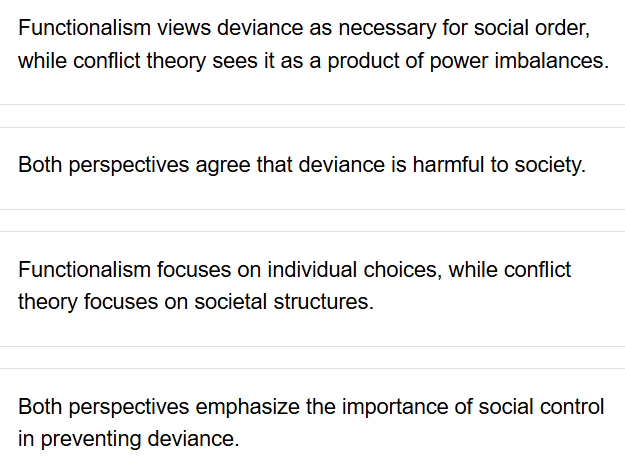In a large urban district, students from wealthier neighborhoods have access to better-funded schools, advanced placement classes, and newer technology. Students from poorer neighborhoods attend overcrowded schools with fewer resources, leading to gaps in test scores and college access.
Conflict Theory
When a person commits deviance once and is not labeled, it’s called this.
primary deviance
Which of the following is an example of a cultural tradition that has changed in the United States?
a. Thanksgiving dinner
b. Celebrating Birthdays
c. Wearing attire to weddings
d. Using smartphones for communication
This country has high birth rates and high death rates. There is little to no population growth, and the society is primarily agricultural. Which stage is it in?
Stage One
********How did the Industrial Revolution contribute to the emergence of the adolescence as a distinct life stage? **********
led to a decrease in child labor laws, juvenile justice system, and education
Students at Jefferson High begin each school day by saying the Pledge of Allegiance, standing for announcements, and using polite greetings with teachers. These routines create a sense of order and shared meaning among students.
Question: Which perspective does this best represent?
Symbolic Interactionism
Which theory emphasizes the role of emotions when trying to mobilize a crowd?
Contagion Theory
Everyday customs like shaking hands or holding a door open.
folkways
*******What are the two distinct characteristics of stage 2 of the demographic transition theory?********
Low birth rates and low death rates
This concept includes the beliefs, values, and language of a society—not the physical objects.
non-material culture
In most societies, families serve the purpose of raising children, teaching values, and providing emotional and economic support. Each family member typically has defined roles, like parent, sibling, or child, that help the family function smoothly.
Functionalism
This is the process of restoring a deviant person to a law-abiding one
rehabilitation
A behavior so unacceptable it's met with disgust or punishment
taboo
Social expectations and roles based on whether someone is male or female.
gender
If a country has a growing aging population with a low death rate and a low birth rate what could happen to the country?
increased demand for age-related services and products
A group of workers stages a nationwide protest for fair wages and better working conditions, arguing that corporate leaders exploit labor for profit. The protest results in new labor laws being passed.
Conflict Theory
One negative effect of tech-fueled social movements that require minimal effort
slacktivism
Rewards or punishments used to encourage following norms
sanctions
Here, birth rates begin to decline as families choose to have fewer children. Urbanization and education—especially for women—increase.
Stage 3
This legal system was created to treat young offenders differently from adults, acknowledging their stage of development.
juvenile justice system
A student is caught skipping class once and is labeled a “troublemaker” by teachers. Over time, the student embraces this identity and continues engaging in deviant behavior, feeling excluded from school activities
Symbolic Interactionism
The healthcare movement has grown and formed an official nonprofit organization with paid staff, office space, lobbyists, and a structured plan to work with Congress.
Bureaucratization
People begin sharing personal stories on social media about unsafe drinking water in their city. Hashtags trend, and frustration grows, but no formal group has taken action yet.
Emergence
A developing country sees declining death rates due to vaccination programs and public health improvements, but its birth rate remains unchanged.
Stage 2
In the early 1900s, child labor laws and mandatory schooling helped create this new life stage.
adolescence
******How does the functionalist perspective on deviance differ from the conflict perspective?******

****What is the difference between subculture and counterculture?****
Bonus:What is an example of counterculture?
****Subculture conform to mainstream society, while countercultures reject it.****
*******How does the digital divide impact education equity and student achievement? *******
Create wide education gap by limiting access to technology for low-income students.
Table asks your team any question
answer will vary
What is a key characteristic of class systems and class systems
Achieved status and birth status
Achieved Status